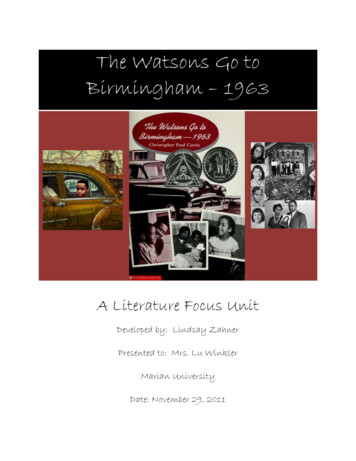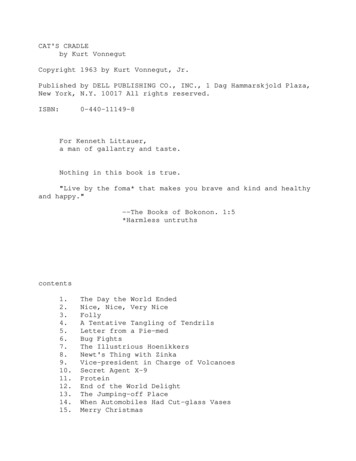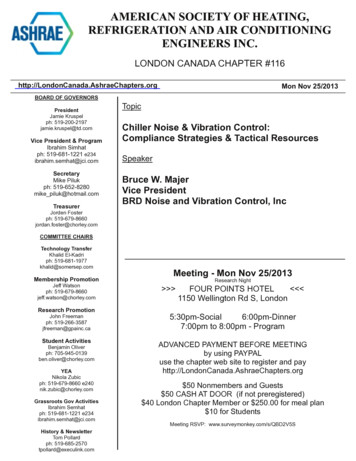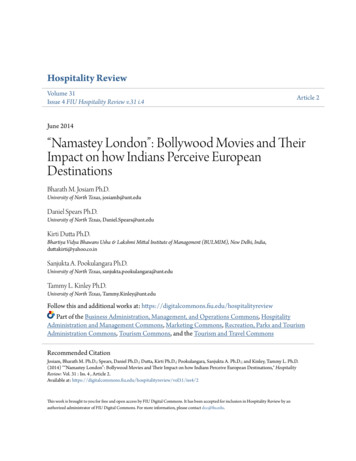
Transcription
Goffman, Erving(1963) Stigma. London: Penguin.Noter om layout:- footnote på nesten hver side, markert med ((footnote)) og varer til nytt sidetall- sidetall nederst på hver sideInnholdsfortegnelse i word:Goffman, Erving(1963) Stigma. London: Penguin. 1Noter om layout: . 1Innholdsfortegnelse i word: . 1Contents . 3Preface. 41 Stigma and Social Identity . 52 Information Control anPersonal Identity . 373. Group alignment and Ego identity. 884 The Self and Its Other . 1045 Deviations and Deviance . 115READ MORE IN PENGUIN . 121
S TIGMANotes on the Management of Spoiled IdentityERVING GOFFMANPenguin BooksPENGUIN BOOKSPublished by the Penguin GroupPenguin Books Ltd, 27 Wrights Lane, London W8 5TZ, EnglandPenguin Books USA Inc., 375 Hudson Street, New York, New York 10014, USA PenguinBooks Australia Ltd, Ringwood, Victoria, AustraliaPenguin Books Canada Ltd, 10 Alcorn Avenue, Toronto, Ontario, Canada M4V 3B2 PenguinBooks (NZ) Ltd, 182-190 Wairau Road, Auckland 10, New ZealandPenguin Books Ltd, Registered Offices: Harmondsworth, Middlesex, EnglandOriginal American edition published by Prentice-Hall Inc.,Englewood Cliffs, New Jersey, USA, 1963Published in Pelican Books 1968Reprinted in Penguin Books 1990 10 9 8 7 6 5 4Copyright C Prentice-Hall Inc., 1963 All rights reservedPrinted in England by Clays Ltd, St Ives plc Set in MonotypeBaskervilleExcept in the United States of America, this book is sold subjectto the condition that it shall not, by way of trade or otherwise, be lent, re-sold, hiredout, or otherwise circulated without the publisher's prior consent in any form of bindingor cover other than that in which it is published and without a similar conditionincluding this condition being imposed on the subsequent purchaser
ContentsPreface91 Stigma and Social IdentityPreliminary Conceptions, rr; The Own and the Wise, 31; Moral Career, 452 Information Control and Personal Identity57The Discredited and the Discreditable, 57; Social Information, 58; Visibility, 64; PersonalIdentiy, 68; Biography, 8o; Biographical Others, 85; Passing, 92; Techniques of InformationControl, 113 Covering, 1253 Group Alignment and Ego Identity129Ambivalence, 130; Professional Presentations, 132 ; In-Group Alignments, 137; Out-GroupAlignments, 13g; The Politics of Identity, 1494 The Self and Its Other151Deviations and Norms, ryr; The Normal Deviant, 155; Stigma and Reality, 6'r((11))5 Deviations and Deviance167Dear Miss LonelyheartsI am sixteen years old now and I dont know what to do and would appreciate it if you couldtell me what to do. When I was a little girl it was not so bad because I got used to the kids on theblock makeing fun of me, but now I would like to have boy friends like the other girls and goout on Saturday nites, but no boy will take me because I was born without a nose — although Iam a good dancer and have a nice shape and my father buys me pretty clothes.I sit and look at myself all day and cry. I have a big hole in the middle of my face that scarespeople even myself so I cant blame the boys for not wanting to take me out. My mother lovesme, but she crys terrible when she looks at me.What did I do to deserve such a terrible bad fate? Even if I did do some bad things I didn't doany before I was a year old and I was born this way. I asked Papa and he says he doesn't know,but that maybe I did something in the other world before I was born or that maybe I was beingpunished for his sins. I dont believe that because he is a very nice man. Ought I commit suicide?
Sincerely yours,DesperateFrom Miss Lonelyhearts by Nathanael West, pp. 14—15. Copyright Q 1962 by NewDirections. Reprinted by permission of New Directions, Publishers.PrefaceFor over a decade now in the literature of social psychology there has been good work done onstigma — the situation of the individual who is disqualified from full social acceptance.) Thiswork has been added to from time to time by useful clinical studies,2 and its framework appliedto ever new categories of persons.3In this essay4 I want to review some work on stigma, especially some popular work, to seewhat it can yield for sociology. An exercise will be undertaken in marking off the material onstigma from neighbouring facts, in showing how this material can be economically describedwithin a singlez. Most notably, among sociologists, E. Lemen; among psychologists, K. Lewin, F. Heider, T.Dembo, R. Barker and B. Wright. See especially B. Wright, Physical Disability – APsychological Approach (New York: Harper & Row, z g6o), which has provided me with manyre-quotable quotations and many useful references.2.For example, F. Macgregor et at., Facial Deformities and Plastic Surgery (Springfield, Ill.:Charles C. Thomas, z953).3.For example, C. Orbach, M. Bard and A. Sutherland, Fears and Defensive Adaptations tothe Loss of Anal Sphincter Control', Psycho-analytical Review, XLIV (1957), I2I–75.4.An earlier summary version is printed in M. Greenblatt, D. Levin-son and R. Williams,The Patient and the Mental Hospital (New York: Free Press of Glencoe, 1957), pp. 507-10. Alater version was presented as the MacIver Lecture at the Southern Sociological Society,Louisville, Kentucky, 13 April 1962. Assistance with the current version was received fromthe Center for the Study of Law and Society, University of California, Berkeley, under a grantfrom the President's Committee on Juvenile Delinquency.conceptual scheme, and in clarifying the relation of stigma to the subject matter of deviance.This task will allow me to formulate and use a special set of concepts, those that bear on socialinformation', the information the individual directly conveys about himself.
1 Stigma and Social IdentityThe Greeks, who were apparently strong on visual aids, originated the term stigma to refer tobodily signs designed to expose something unusual and bad about the moral status of thesignifier. The signs were cut or burnt into the body and advertised that the bearer was a slave, acriminal, or a traitor — a blemished person, ritually polluted, to be avoided, especially in publicplaces. Later, in Christian times, two layers of metaphor were added to the term : the firstreferred to bodily signs of holy grace that took the form of eruptive blossoms on the skin; thesecond, a medical allusion to this religious allusion, referred to bodily signs of physical disorder.Today the term is widely used in something like the original literal sense, but is applied more tothe disgrace itself than to the bodily evidence of it. Furthermore, shifts have occurred in the kindsof disgrace that arouse concern. Students, however, have made little effort to describe thestructural preconditions of stigma, or even to provide a definition of the concept itself. It seemsnecessary, therefore, to try at the beginning to sketch in some very general assumptions anddefinitions.Preliminary ConceptionsSociety establishes the means of categorizing persons and the complement of attributes felt to beordinary and natural for members of each of these categories. Social((11))settings establish the categories of persons likely to be encountered there. The routines of socialintercourse in established settings allow us to deal with anticipated others without specialattention or thought. When a stranger comes into our presence, then, first appearances are likelyto enable us to anticipate his category and attributes, his social identity' – to use a term that isbetter than social status' because personal attributes such as honesty' are involved, as well asstructural ones, like occupation'.We lean on these anticipations that we have, transforming them into normative expectations,into righteously presented demands.Typically, we do not become aware that we have made these demands or aware of what theyare until an active question arises as to whether or not they will be fulfilled. It is then that weare likely to realize that all along we had been making certain assumptions as to what theindividual before us ought to be. Thus, the demands we make might better be called demandsmade in effect', and the character we impute to the individual might better be seen as an imputation made in potential retrospect – a characterization in effect', a virtual social identity.The category and attributes he could in fact be proved to possess will be called his actual socialidentity.While the stranger is present before us, evidence can arise of his possessing an attribute thatmakes him different from others in the category of persons available for him to be, and of a less
desirable kind – in the extreme, a person who is quite thoroughly bad, or dangerous, or weak.He is thus reduced in our minds from a whole and usual person to a tainted, discounted one.Such an attribute is a stigma, especially when its discrediting effect is very extensive; sometimes it is also called a failing, a shortcoming, a handicap. It constitutes a special discrepancybetween virtual and((12))actual social identity. Note that there are other types of discrepancy between virtual and actualsocial identity, for example the kind that causes us to reclassify an individual from one sociallyanticipated category to a different but equally well-anticipated one, and the kind that causes usto alter our estimation of the individual upward. Note, too, that not all undesirable attributes areat issue, but only those which are incongruous with our stereotype of what a given type ofindividual should be.The term stigma, then, will be used to refer to an attribute that is deeply discrediting, but itshould be seen that a language of relationships, not attributes, is really needed. An attribute thatstigmatizes one type of possessor can con-firm the usualness of another, and therefore is neithercreditable nor discreditable as a thing in itself. For example, some jobs in America cause holderswithout the expected college education to conceal this fact; other jobs, however, can lead thefew of their holders who have a higher education to keep this a secret, lest they be marked asfailures and out-siders. Similarly, a middle class boy may feel no compunction in being seengoing to the library; a professional criminal, however, writesI can remember before now on more than one occasion, for in-stance, going into a publiclibrary near where I was living, and looking over my shoulder a couple of times before I actuallywent in just to make sure no one who knew me was standing about and 'seeing me do it?.So, too, an individual who desires to fight for his country may conceal a physical defect, lest hisclaimed physical status be discredited; later, the same individual, embittered and trying to getout of the army, may succeed in gaining admission to the army hospital, where he would bediscredited((footnote))i.T. Parker and R. Allerton, The Courage of His Convictions, London, Hutchinson, 1962, p. iog.((13))if discovered in not really having an acute sickness.' A stigma, then, is really a special kind ofrelationship between attribute and stereotype, although I don't propose to continue to say so, inpart because there are important attributes that almost everywhere in our society are discrediting.The term stigma and its synonyms conceal a double perspective : does the stigmatizedindividual assume his differentness is known about already or is evident on the spot, or does heassume it is neither known about by those present nor immediately perceivable by them? In thefirst case one deals with the plight of the discredited, in the second with that of the discreditable.
This is an important difference, even though a particular stigmatized individual is likely to haveexperience with both situations. I will begin with the situation of the discredited and move on tothe discreditable but not always separate the two.Three grossly different types of stigma may be mentioned. First there are abominations of thebody - the various physical deformities. Next there are blemishes of individual characterperceived as weak will, domineering or unnatural passions, treacherous and rigid beliefs, anddishonesty, these being inferred from a known record of, for example, mental disorder,imprisonment, addiction, alcoholism, homosexuality, unemployment, suicidal attempts, andradical political behaviour. Finally there are the tribal stigma of race, nation, and religion, thesebeing stigma that can be transmitted through lineages and equally contaminate all members of afamily.' In all of these various((footnote))2. In this connexion see the review by M. Meltzer, Countermanipulation throughMalingering', in A. Biderman and H. Zimmer, eds, The Manipulation of Human Behavior, NewYork, John Wiley, i Øt, pp. 277-304.((14))instances of stigma, however, including those the Greeks had in mind, the same sociologicalfeatures are found : an individual who might have been received eaily in ordinary socialintercourse possesses a trait that can obtrude itself upon attention and turn those of us whom hemeets away from him, breaking the claim that his other attributes have on us. He possesses astigma, an undesired differentness from what we had anticipated. We and those who do notdepart negatively from the particular expectations at issue I shall call the normals.The attitudes we normals have towards a person with a stigma, and the actions we take inregard to him, are well known, since these responses are what benevolent social action isdesigned to soften and ameliorate. By definition, of course, we believe the person with a stigmais not quite human. On this assumption we exercise varieties of discrimination, through whichwe effectively, if often un-thinkingly, reduce his life chances. We construct a stigma theory, anideology to explain his inferiority and account for the danger he represents, sometimesrationalizing an animosity based on other differences, such as those of social class.4 We usespecific stigma terms such as cripple, bastard, moron in our daily discourse as a source ofmetaphor and imagery, typically without giving thought to the original meaning.5 We tend toimpute a wide range of imperfections((footnote))3.In recent history, especially in Britain, low class status functioned as an important tribalstigma, the sins of the parents, or at least their milieu, being visited on the child, should thechild rise improperly far above his initial station. The management of class stigma is ofcourse a central theme in the English novel.4.D. Riesman, Some Observations Concerning Marginality', Phylon, Second Quarter,1951, p. 122.5.The case regarding mental patients is presented by T. J. Schefin a forthcoming paper.
((15))on the basis of the original one, and at the same time to impute some desirable but undesiredattributes, often of asupernatural cast, such as sixth sense', or understanding' :7For some, there may be a hesitancy about touching or steering the blind, while for others, theperceived failure to see may be generalized into a gestalt of disability, so that the individualshouts at the blind as if they were deaf or attempts to lift them as if they were crippled. Thoseconfronting the blind may have a whole range of belief that is anchored in the stereotype. Forinstance, they may think they are subject to unique judgement, assuming the blinded individualdraws on special channels of information un-available to others. Further, we may perceive his defensive response to his situation as a direct expression of hisdefect, and then see both defect and response as just retribution for something he or his parentsor his tribe did, and hence a justificationof the way we treat him.9Now turn from the normal to the person he is normal against. It seems generally true thatmembers of a social category may strongly support a standard of judgement that they and othersagree does not directly apply to them.Thus it is that a businessman may demand womanly behaviour from females or ascetic behaviourfrom monks; and not construe himself as someone who ought to realize6.In regard to the blind, see E. Henrich and L. Kriegel, eds, Experiments in Survival, NewYork, Association for the Aul of Crippled Children, 196 i, pp. 152 and 186; and H. Chevigny,My Eyes Have a Cold Nase, New Haven, Conn., Yale University Press, paperbound, 1962, p.201.7.In the words of one blind woman, I was asked to endorse a perfume, presumably becausebeing sightless my sense of smell was super-discriminating.' See T. Keitlen (with N. Lobsenz),Farewell to Fear, New York, Avon, 1962, p. to.8.A. G. Gowman, The War Blind in American Social Structure, New York: AmericanFoundation for the Blind, 1957, p. 98.9.For examples, see Macgregor et al., op. cit., throughout.((16))either of these styles of conduct The distinction is between realizing a norm and merelysupporting it. The issue of stigma does not arise here, but only where there is some expectationon all sides that those in a given category should not only support a particular norm but alsorealize it.
Also, it seems possible for an individual to fail to live up to what we effectively demand ofhim, and yet be relatively untouched by this failure; insulated by his alienation, protected byidentity beliefs of his own, he feels that he is a full-fledged normal human being, and that we arethe ones who are not quite human. He bears a stigma but does not seem to be impressed orrepentant about doing so. This possibility is celebrated in exemplary tales about Mennonites,Gypsies, shameless scoundrels, and very orthodox Jews.In America at the present, however, separate systems of honour seem to be on the decline.The stigmatized individual tends to hold the same beliefs about identity that we do; this is apivotal fact. His deepest feelings about what he is may be his sense of being a normal person', ahuman being like anyone else, a person, therefore, who deserves a fair chance and a fairbreak.10 (Actually, however phrased, he bases his claims not on what he thinks is due everyone,but only everyone of a selected social category into which he unquestionably fits, for example,anyone of his age, sex, profession, and so forth.) Yet he may perceive, usually quite correctly,that whatever others profess, they do not really((17))to. The notion of normal human being' may have its source in the medical approach tohumanity or in the tendency of large-scale bureaucratic organizations, such as the nation state,to treat all members in some respects as equal. Whatever its origins, it seems to provide thebasic imagery through which laymen currently conceive of themselves. Interestingly, aconvention seems to have emerged in popular life-story writing where a questionable personproves his claim to normalcy by citing his acquisition of a spouse and children, and, oddly, byåttesting to his spending Christmas and Thanksgiving with them. accept' him and are not ready to make contact with him on equal grounds .0 Further, thestandards he has incorporated from the wider society equip him to be intimately alive to whatothers see as his failing, inevitably causing him, if only for moments, to agree that he doesindeed fall short of whit he really ought to be. Shame becomes a central possibility, arisingfrom the individual's perception of one of his own attributes as being a defiling thing topossess, and one he can readily see himself as not possessing.The immediate presence of normals is likely to reinforce this split between self-demands andself, but in fact self-hate and self-derogation can also occur when only he and a mirror areabout:When I got up at last . . . and had learned to walk again, one day I took a hand glass andwent to a long mirror to look at myself, and I went alone. I didn't want anyone . . . to knowhow I felt when I saw myself for the first time. But there was no noise, no outcry; I didn'tscream with rage when I saw myself. I just felt numb. That person in the mirror couldn't beme. I felt inside like a healthy, ordinary, lucky person - oh, not like the one in the mirror! Yetwhen I turned my face to the mirror there were my own eyes look-ing back, hot with shame . . when I did not cry or make any sound, it became impossible that I should speak of it toanyone, and the confusion and the panic of my discovery were locked inside me then andthere, to be faced alone, for a very long time to come."'Over and over I forgot what I had seen in the mirror. It could not penetrate into the interiorof my mind and become an integral part of me. I felt as if it had nothing-to do with me; it was
only a disguise. But it was not the kind of disguise which is put on voluntarily by the personwho wears it, and which is intended to confuse other people as to one's identity. My disguisehad been put on me((footnote))1i. A criminal's view of this non-acceptance is presented in Parker and Allerton, op. cit., pp.1 io-i i.12.K. B. Hathaway, The Little Locksmith, New York, Coward MØ, 1943, P. 41, in Wright, Ø.cit., p. 157.13.((18))without my consent or knowledge like the ones in fairy tales, and it was I myself who wasconfused by it, as to my own identity. I looked in the mirror, and was horror-struck because Idid not recognize myself. In the place where I was standing, with that persistent romantic elationin me, as if I were a favoured fortunate person, to whom everything was possible, I saw astranger, a little, pitiable, hideous figure, and a face that became, as I stared at it, painful andblushing with shame. It was only a disguise, but it was on me, for life. It was there, it was there,it was real. Every one of those encounters was like a blow on the head. They left me dazed anddumb and senseless every time, until slowly and stubbornly my robust persistent illusion ofwell-being and of personal beauty spread all through me again, and I forgot the irrelevant realityand was all unprepared and vulnerable again.0The central feature of the stigmatized individual's situation in life can now be stated. It is aquestion of what is often, if vaguely, called acceptance'. Those who have dealings with him failto accord him the respect and regard which the un-contaminated aspects of his social identityhave led them to anticipate extending, and have led him to anticipate receiving; he echoes thisdenial by endingthat some of his own attributes warrant it.How does the stigmatized person respond to his situation ? In some cases it will be possiblefor him to make a direct attempt to correct what he sees as the objective basis of his failing, aswhen a physically deformed person undergoes plastic surgery, a blind person eye treatment, anilliterate remedial education, a homosexual psychotherapy. (Where such repair is possible, whatoften results is not the acquisition((footnote))13. Ibid., pp. 46-47. For general treatments of the self-fl luringsentiments, see K. Lewin, Resolving Social Conflicts, Part III, New York, Harper & Row, r94Ø; A.Kardiner and L. Ovesey, The Mark of Oppression: A Psychosocial Study of the American Negro,New York, W. W. Norton, 1951; and E. IL Erikson, Childlwod and Society, New York, W. W.Norton, 1950.((19))
of fully normal status, but a transformation of self from some-one with a particular blemish intosomeone with a record of having corrected a particular blemish.) Here proneness to victimization' is to be cited, a result of the stigmatized person's exposure to fraudulent serversselling speech correction, skin lighteners, body stretchers, youth restorers (as in rejuvenationthrough fertilized egg yolk treatment), cures through faith, and poise in conversation. Whether apractical technique or fraud is involved, the quest, often secret, that results provides a specialindication of the extremes to which the stigmatized can be willing to go, and hence thepainfulness of the situation that leads them to these extremes. One illustration may be cited :Miss Peck [a pioneer New York social worker for the hard of hearing] said that in the earlydays the quacks and get-rich-quick medicine men who abounded saw the League [for the hardof hearing] as their happy hunting ground, ideal for the promotion of magnetic head caps,miraculous vibrating machines, artificial eardrums, blowers, inhalers, massagers, magic oils,balsams, and other guaranteed, sure-fire, positive and permanent cure-alls for incurabledeafness. Advertisements for such hokum (until the ig2os when the American MedicalAssociation moved in with an investigation campaign) beset the hard of hearing in the pages ofthe daily press, even in reputable magazines."The stigmatized individual can also attempt to correct his condition indirectly by devotingmuch private effort to the mastery of areas of activity ordinarily felt to be closed on incidentaland physical grounds to one with his shortcoming. This is illustrated by the lame person wholearns or re-learns to swim, ride, play tennis, or fly an airplane, or the blind person who becomesexpert at skiing and mountain((footnote))14. F. WarØ, Ksep Listening, New York, The Viking Preto, 1957, p. 76. See also H. vonHentig, The Criminal and His Victim, New Haven, Conn,. Yale University Press, 1948, p. 101.((20))climbing." Tortured learning may be associated, of course, with the tortured performance ofwhat is learned, as when an individual, confined to a wheelchair, manages to take to the dancefloor with a girl in some kind of mimicry of dancing.ls Finally, the person with a shamefuldifferentness can break with what is called reality, and obstinately attempt to employ anunconventional interpretation of the character of his social identity.The stigmatized individual is likely to use his stigma for secondary gains', as an excuse for illsuccess that has come his way for other reasons :For years the scar, harelip or misshapen nose has been looked on as a handicap, and itsimportance in the social and emotional adjustment is unconsciously all embracing. It is the hook' on which the patient has hung all inadequacies, all dissatisfactions, all procrastinationsand all unpleasant duties of social life, and he has come to depend on it not only as a reasonableescape from competition but as a protection from social responsibility.
When one removes this factor by surgical repair, the patient is cast adrift from the more orless acceptable emotional protection it has offered and soon he finds, to his surprise anddiscomfort, that life is not all smooth sailing even for those with unblemished, 'ordinary ' faces.He is unprepared to cope with this situation without the support of a handicap', and he mayturn to the less simple, but similar, protection of the behavior patterns of neurasthenia,hysterical conversion, hypochondriasis or the acute anxiety states.17He may also see the trials he has suffered as a blessing in((footnote))15.Keitlen, op. cit., Chap. 12, pp. 117-29 and Chap. 14, pp. 137-49. See also Chevigny, op.cit., pp. 85-86.16.Henrich and Kriegel, Ø. cit., p. 49.17.W. Y. Baker and L. H. Smith, 'Facial Disfigurement and Personality', journal of theAmerican Medical Association, CXII (1939), 303. Macgregor et al., op. cit., p. 57 if., providean illustration ofa man who used his big red nose for a crutch.((21))disguise, especially because of what it is felt that suffering canteach one about life and people :But now, far away from the hospital experience, I can evaluate what I have learned. [A motherpermanently disabled by polio writes.] For it wasn't only suffering: it was also learning throughsuffering. I know my awareness of people has deepened and in-creased, and those who are closeto me can count on me to turn all my mind and heart and attention to their problems. I could nothave learned that dashing all over a tennis court.18Correspondingly, he can come to re-assess the limitations of normals, as a multiple scleroticsuggests :Both healthy minds and healthy bodies may be crippled. The fact that normal' people can getaround, can see, can hear, doesn't mean that they are seeing or hearing. They can be very blind tothe things that spoil their happiness, very deaf to the pleas of others for kindness; when I think ofthem I do not feel any more crippled or disabled than they. Perhaps in some small way I can bethe means of opening their eyes to the beauties around us; things like a warm handclasp, a voicethat is anxious to cheer, a spring breeze, music to listen to, a friendly nod. These people areimportant to me, and I like to feel that I can help them."And a blind writer :That would lead immediately to the thought that there are many occurrences which candiminish satisfaction in living far more effectively than blindness, and that lead would be anentirely healthy one to take. In this light, we can perceive, for instance, that some inadequacylike the inability to accept human love, which can effectively diminish satisfaction of livingalmost to the vanish-ing point, is far more a tragedy than blindness. But it is unusual for the man
who suffers from such a malady even to know he has it and self pity is, t
Books (NZ) Ltd, 182-190 Wairau Road, Auckland 10, New Zealand Penguin Books Ltd, Registered Offices: Harmondsworth, Middlesex, England Original American edition published by Prentice-Hall Inc., Englewood Cliffs, New Jersey, USA, 1963 Published in Pelican Books 1968 Reprin

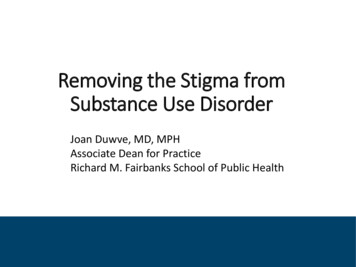
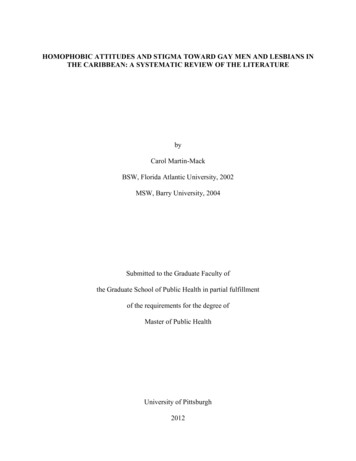
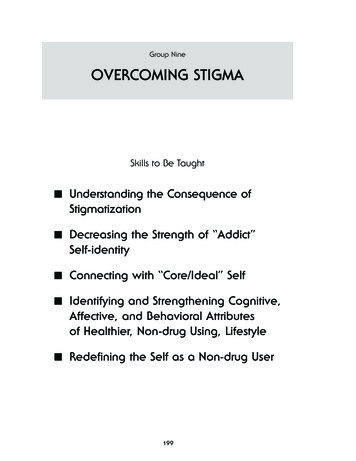
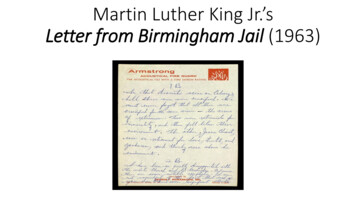
![Letter from Birmingham Jail (1963) [Abridged]](/img/2/1963-mlk-letter-abridged.jpg)
